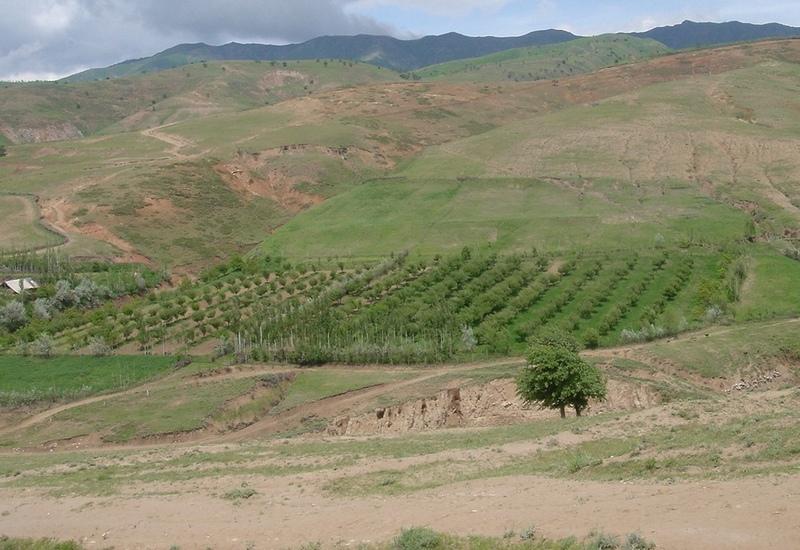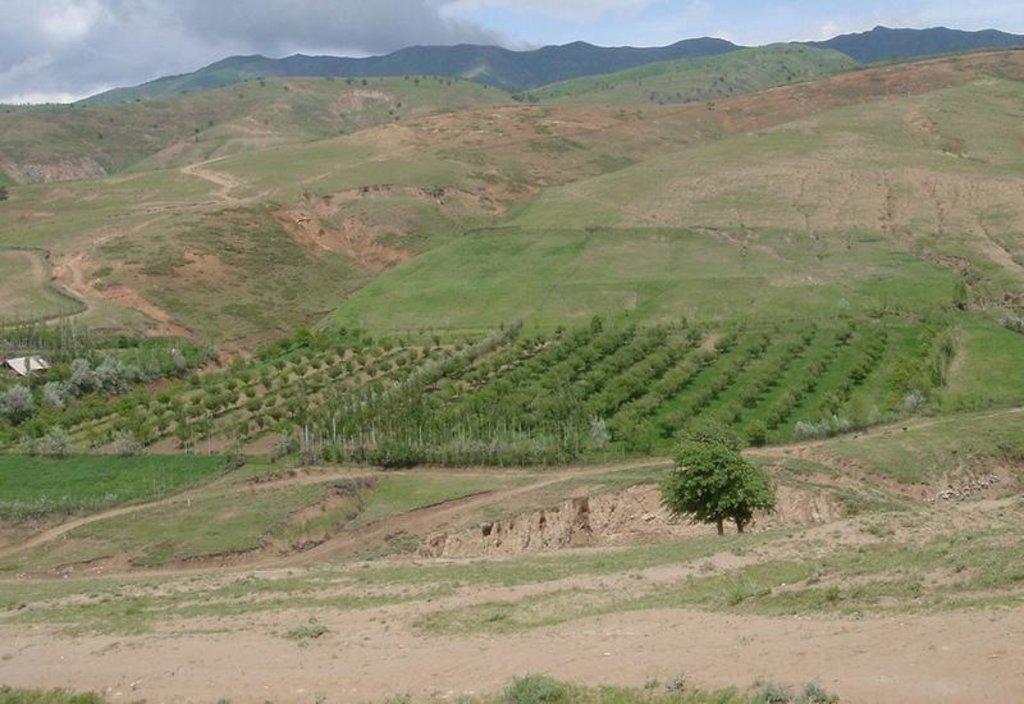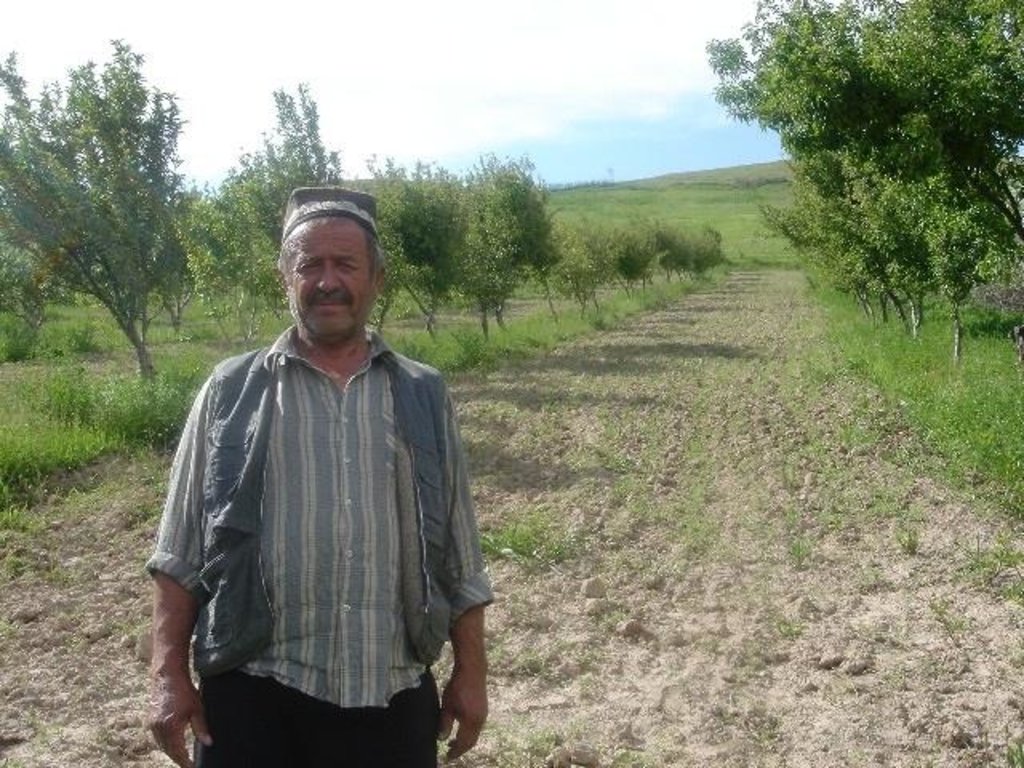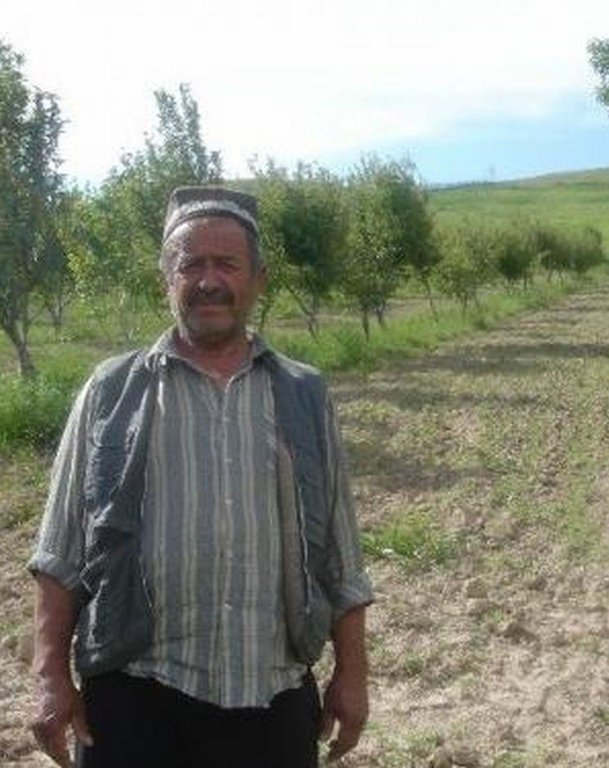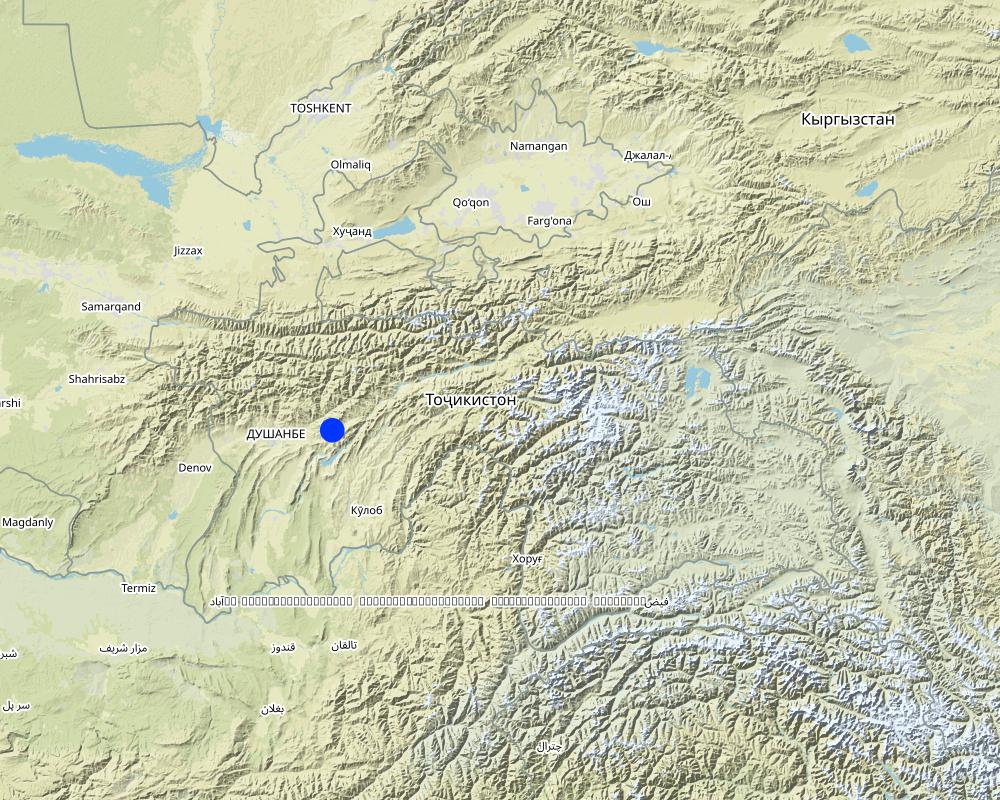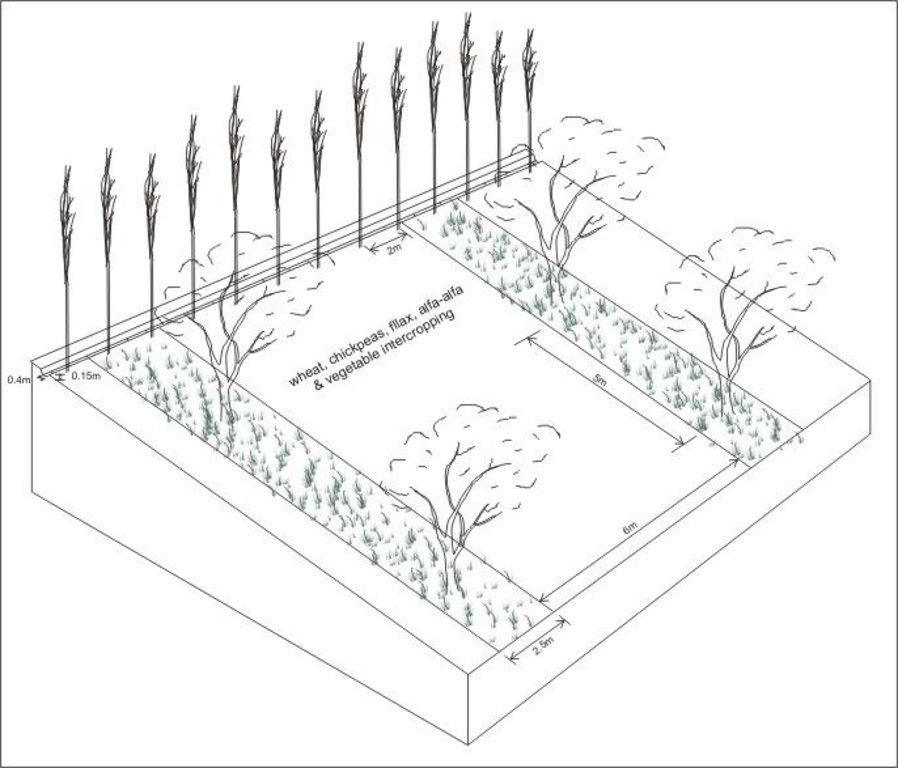Orchard-based Agroforestry (establishment of orchard) [Tajikistan]
- Creation:
- Update:
- Compiler: Erik Bühlmann
- Editor: –
- Reviewers: David Streiff, Alexandra Gavilano, Joana Eichenberger
technologies_1001 - Tajikistan
- Full summary as PDF
- Full summary as PDF for print
- Full summary in the browser
- Full summary (unformatted)
- Orchard-based Agroforestry (establishment of orchard): Aug. 20, 2019 (inactive)
- Orchard-based Agroforestry (establishment of orchard): Nov. 2, 2021 (public)
- Orchard-based Agroforestry (establishment of orchard): July 19, 2017 (inactive)
- Orchard-based Agroforestry (establishment of orchard): July 17, 2017 (inactive)
- Orchard-based Agroforestry (establishment of orchard): March 10, 2017 (inactive)
View sections
Expand all Collapse all1. General information
1.2 Contact details of resource persons and institutions involved in the assessment and documentation of the Technology
SLM specialist:
Name of project which facilitated the documentation/ evaluation of the Technology (if relevant)
Pilot Program for Climate Resilience, Tajikistan (WB / PPCR)Name of the institution(s) which facilitated the documentation/ evaluation of the Technology (if relevant)
CDE Centre for Development and Environment (CDE Centre for Development and Environment) - SwitzerlandName of the institution(s) which facilitated the documentation/ evaluation of the Technology (if relevant)
NCCR North-South (NCCR North-South) - Kyrgyzstan1.3 Conditions regarding the use of data documented through WOCAT
The compiler and key resource person(s) accept the conditions regarding the use of data documented through WOCAT:
Yes
1.5 Reference to Questionnaire(s) on SLM Approaches (documented using WOCAT)

Voluntary Labour Assistance [Tajikistan]
Voluntary labour assistance for labour intensive activities whereby community members help each other in contributing labour on the basis of mutual understanding.
- Compiler: Erik Bühlmann
2. Description of the SLM Technology
2.1 Short description of the Technology
Definition of the Technology:
Establishment of an orchard intercropping system on severely degraded cropland.
2.2 Detailed description of the Technology
Description:
A fruit orchard (consisting of apples, apricots, cherries, pears and nut trees) was established on degraded cropland. Intercropping of annual crops such as wheat, flax, chick peas and vegetables as well as perennial herbaceous fodder plants (alfa-alfa and esparzet) were planted after the first year of the establishment of the orchard. Only the onion plot is rotated systematically since the farmer states that fertility declines due to heavy soil losses result from over-irrigation. Spacing of tree rows varies between 8-10m, the intercropping system is cultivated using a tractor. Fruit trees are aligned in the direction of the slope to facilitate irrigation. At the top of the field an irrigation channel (40cm wide, 15cm deep) stabilised with aligned poplar trees directs water onto the orchard system. During the rainy season the channel serves as a cut-off drain, protecting the land from water running on. Along the trees, a 2.5 m wide grass strip protects the ground from splash erosion.
Purpose of the Technology: The orchard system was established to increase farm production by integrating different resources, while simultaneously conserving soil and water resources and preventing development of gullies. Prior to tree planting, the area had been levelled with a bulldozer to restore the severely degraded cropland. The bought seedlings were planted in hand-dug pits. During summer, the orchard system is watered three days per week; manure is applied around the fruit trees on an annual basis. Pruning of the trees is done in early spring. Due to irrigation, the grass strips can be harvested twice a year for haymaking. Farming two crops at a time means gross farm production could be considerably increased, which is the reaon why the farmer considered the technology successful. However, establishment and maintenance of the technology is cost intensive and, in this case study, was only affordable due to the farmers off-farm income. Since the tree rows are aligned up and down the slope, soil erosion is solely reduced by the capability of the irrigation channel (and aligned tree barrier) to prevent the system from runon. Planting tree rows on the gradient would increase the technologies potential to reduce soil loss.
2.3 Photos of the Technology
2.5 Country/ region/ locations where the Technology has been applied and which are covered by this assessment
Country:
Tajikistan
Region/ State/ Province:
RRS
Further specification of location:
Faizabad Rayon
Specify the spread of the Technology:
- evenly spread over an area
If precise area is not known, indicate approximate area covered:
- 0.1-1 km2
Map
×2.7 Introduction of the Technology
Specify how the Technology was introduced:
- during experiments/ research
3. Classification of the SLM Technology
3.1 Main purpose(s) of the Technology
- reduce, prevent, restore land degradation
3.2 Current land use type(s) where the Technology is applied
Land use mixed within the same land unit:
Yes
Specify mixed land use (crops/ grazing/ trees):
- Agroforestry

Cropland
- Annual cropping
- Tree and shrub cropping
Annual cropping - Specify crops:
- legumes and pulses - peas
- fibre crops - flax, hemp, other
- cereals - wheat (spring)
- fodder crops - alfalfa
- vegetables - other
- esparzet
Tree and shrub cropping - Specify crops:
- fruits, other
- stone fruits (peach, apricot, cherry, plum, etc)
- tree nuts (brazil nuts, pistachio, walnuts, almonds, etc.)
- pome fruits (apples, pears, quinces, etc.)
Number of growing seasons per year:
- 1
Specify:
Longest growing period in days: 210Longest growing period from month to month: March - August
Is intercropping practiced?
Yes
If yes, specify which crops are intercropped:
Intercropping of annual crops such as wheat, flax, chick peas and vegetables as well as perennial herbaceous fodder plants (alfa-alfa and esparzet)

Grazing land

Forest/ woodlands
Comments:
Major land use problems (compiler’s opinion): Severe water erosion (gullies and rills) and subsequent decline in fertility on cropland and on overgrazed pastures.
Type of cropping system and major crops comments: If the land is irrigated, then after the harvest of annual crops (mid-July until beginning of August), and there is immediate sowing/planting of vegetables (maize, tomatoes, cucumbers, melon among others), then the harvest of vegetables in late August and September is possible.
3.4 Water supply
Water supply for the land on which the Technology is applied:
- full irrigation
Comments:
Water supply also rainfed
3.5 SLM group to which the Technology belongs
- agroforestry
3.6 SLM measures comprising the Technology

agronomic measures
- A1: Vegetation/ soil cover
- A2: Organic matter/ soil fertility

vegetative measures
- V5: Others

structural measures
- S11: Others

management measures
- M1: Change of land use type
Comments:
Main measures: structural measures
Secondary measures: agronomic measures, vegetative measures
Type of agronomic measures: mixed cropping / intercropping, manure / compost / residues, mineral (inorganic) fertilizers
3.7 Main types of land degradation addressed by the Technology

soil erosion by water
- Wt: loss of topsoil/ surface erosion
- Wg: gully erosion/ gullying

chemical soil deterioration
- Cn: fertility decline and reduced organic matter content (not caused by erosion)
Comments:
Main type of degradation addressed: Wg: gully erosion / gullying
Secondary types of degradation addressed: Wt: loss of topsoil / surface erosion, Cn: fertility decline and reduced organic matter content
3.8 Prevention, reduction, or restoration of land degradation
Specify the goal of the Technology with regard to land degradation:
- prevent land degradation
- reduce land degradation
Comments:
Main goals: prevention of land degradation
Secondary goals: mitigation / reduction of land degradation
4. Technical specifications, implementation activities, inputs, and costs
4.1 Technical drawing of the Technology
Technical specifications (related to technical drawing):
Irrigated orchard system with intercropping; irrigation channel (stabilised by aligned poplar trees) also acts as a cut-off drain to prevent runon.
Location: Chinoro. Faizabad Rayon, RRS
Date: 18.07.2005
Technical knowledge required for field staff / advisors: moderate
Technical knowledge required for land users: moderate
Main technical functions: control of concentrated runoff: drain / divert, improvement of ground cover, stabilisation of soil (eg by tree roots against land slides)
Secondary technical functions: control of raindrop splash, increase in organic matter, increase in nutrient availability (supply, recycling,…), increase / maintain water stored in soil, increase in soil fertility
Mixed cropping / intercropping
Material/ species: wheat, chickpeas, flax, vegetables, alfa-alfa, esparzet
Remarks: between tree rows
Manure / compost / residues
Material/ species: manure
Quantity/ density: 20kg/tree
Remarks: spreading around fruit trees
Mineral (inorganic) fertilizers
Material/ species: silitra and/or superphosphate
Quantity/ density: 200kg/ha
Remarks: only if wheat is intercropped
Vegetative measure: aligned: slope direction
Vegetative material: F : fruit trees / shrubs
Number of plants per (ha): 200
Spacing between rows / strips / blocks (m): 8
Vertical interval within rows / strips / blocks (m): 5
Vegetative measure: aligned: slope direction
Vegetative material: F : fruit trees / shrubs
Spacing between rows / strips / blocks (m): 8
Width within rows / strips / blocks (m): 2
Vegetative measure: aligned: along irigation channel on contour
Vegetative material: F : fruit trees / shrubs
Number of plants per (ha): 50
Vertical interval within rows / strips / blocks (m): 2
Vegetative measure: Vegetative material: F : fruit trees / shrubs
Trees/ shrubs species: poplar trees
Fruit trees / shrubs species: apple, pear, cherry, apricot, peach and nut trees
Grass species: grass cover with esparzet and alfa alfa (sown to improve grass cover)
Slope (which determines the spacing indicated above): 17.00%
Structural measure: diversion ditch / cut-off drain
Depth of ditches/pits/dams (m): 0.15
Width of ditches/pits/dams (m): 0.4
Length of ditches/pits/dams (m): 100
Construction material (earth): earth was moved to fill gullies and large rills
Slope (which determines the spacing indicated above): 17%
Vegetation is used for stabilisation of structures.
Author:
Erik Bühlmann, Berne, Switzerland
4.2 General information regarding the calculation of inputs and costs
Specify currency used for cost calculations:
- USD
Indicate average wage cost of hired labour per day:
3.00
4.3 Establishment activities
| Activity | Timing (season) | |
|---|---|---|
| 1. | land levelling and filling up of gullies | winter/early spring |
| 2. | digging of irrigation channel | spring |
| 3. | acquiring tree seedlings on market or at sovkhoze | |
| 4. | digging of pits | early spring |
| 5. | planting seedlings in pits | early spring |
| 6. | sowing of esparzet and alfa alfa (grass strips) to get intact grass cover | spring |
4.4 Costs and inputs needed for establishment
| Specify input | Unit | Quantity | Costs per Unit | Total costs per input | % of costs borne by land users | |
|---|---|---|---|---|---|---|
| Labour | land levelling | ha | 1.0 | 45.0 | 45.0 | 100.0 |
| Equipment | tools | ha | 1.0 | 25.0 | 25.0 | 100.0 |
| Equipment | machine for land levelling | ha | 1.0 | 150.0 | 150.0 | |
| Plant material | seedlings | ha | 1.0 | 250.0 | 250.0 | 100.0 |
| Total costs for establishment of the Technology | 470.0 | |||||
| Total costs for establishment of the Technology in USD | 470.0 | |||||
4.5 Maintenance/ recurrent activities
| Activity | Timing/ frequency | |
|---|---|---|
| 1. | clearing of irigation channel/cut-off drain from washed in soil | rainy season/weekly |
| 2. | periodical irrigation (3x a week) | summer /three days/week |
| 3. | periodical irrigation (3x a week) | summer /three days/week |
| 4. | application of manure | early spring /annual |
| 5. | application of manure | early spring /annual |
| 6. | application of pesticides | spring /annual |
| 7. | application of pesticides | spring /annual |
| 8. | pruning of fruit trees | winter/early spring /annual |
| 9. | pruning of fruit trees | winter/early spring /annual |
| 10. | cutting of grass (haymaking) | summer /twice a cropping season |
| 11. | cutting of grass (haymaking) | summer /twice a cropping season |
| 12. | ploughing of area between tree rows (disc plough) | depending on crop / annual |
| 13. | applying of mineral fertilisers | spring / annual (only for intercropped wheat) |
| 14. | weeding | spring / regularly |
| 15. | applying manure around fruit trees | winter/spring /annual |
4.6 Costs and inputs needed for maintenance/ recurrent activities (per year)
| Specify input | Unit | Quantity | Costs per Unit | Total costs per input | % of costs borne by land users | |
|---|---|---|---|---|---|---|
| Labour | ploughing of area | ha | 1.0 | 20.0 | 20.0 | 100.0 |
| Labour | sowing and weeding | ha | 1.0 | 18.0 | 18.0 | |
| Labour | pruning of fruit trees | ha | 1.0 | 30.0 | 30.0 | |
| Labour | spraying trees with biocides | ha | 1.0 | 12.0 | 12.0 | |
| Plant material | seeds | ha | 1.0 | 30.0 | 30.0 | 100.0 |
| Plant material | 1.0 | |||||
| Fertilizers and biocides | fertilizer | ha | 1.0 | 50.0 | 50.0 | 100.0 |
| Fertilizers and biocides | biocides | ha | 1.0 | 10.0 | 10.0 | 100.0 |
| Fertilizers and biocides | compost/manure | ha | 1.0 | 40.0 | 40.0 | 100.0 |
| Total costs for maintenance of the Technology | 210.0 | |||||
| Total costs for maintenance of the Technology in USD | 210.0 | |||||
Comments:
Costs were calculated for a 100x100 m field plot (with a projected 200 fruit trees/ha).
4.7 Most important factors affecting the costs
Describe the most determinate factors affecting the costs:
Number of trees planted: since the establishment and maintainance require considerable financial and labour inputs; expenditures for tree seedlings bought from the market: N.B. if nursing the trees is completed by land user himself, establishment costs can be halved.
5. Natural and human environment
5.1 Climate
Annual rainfall
- < 250 mm
- 251-500 mm
- 501-750 mm
- 751-1,000 mm
- 1,001-1,500 mm
- 1,501-2,000 mm
- 2,001-3,000 mm
- 3,001-4,000 mm
- > 4,000 mm
Agro-climatic zone
- sub-humid
growing period between 180-210 days
5.2 Topography
Slopes on average:
- flat (0-2%)
- gentle (3-5%)
- moderate (6-10%)
- rolling (11-15%)
- hilly (16-30%)
- steep (31-60%)
- very steep (>60%)
Landforms:
- plateau/plains
- ridges
- mountain slopes
- hill slopes
- footslopes
- valley floors
Altitudinal zone:
- 0-100 m a.s.l.
- 101-500 m a.s.l.
- 501-1,000 m a.s.l.
- 1,001-1,500 m a.s.l.
- 1,501-2,000 m a.s.l.
- 2,001-2,500 m a.s.l.
- 2,501-3,000 m a.s.l.
- 3,001-4,000 m a.s.l.
- > 4,000 m a.s.l.
5.3 Soils
Soil depth on average:
- very shallow (0-20 cm)
- shallow (21-50 cm)
- moderately deep (51-80 cm)
- deep (81-120 cm)
- very deep (> 120 cm)
Soil texture (topsoil):
- medium (loamy, silty)
Topsoil organic matter:
- low (<1%)
If available, attach full soil description or specify the available information, e.g. soil type, soil PH/ acidity, Cation Exchange Capacity, nitrogen, salinity etc.
Soil fertility: medium
Soil drainage / infiltration: medium
5.6 Characteristics of land users applying the Technology
Market orientation of production system:
- subsistence (self-supply)
- mixed (subsistence/ commercial)
Off-farm income:
- > 50% of all income
Relative level of wealth:
- average
- rich
Level of mechanization:
- manual work
- mechanized/ motorized
Indicate other relevant characteristics of the land users:
5% of the land users are rich and own 15% of the land.
75% of the land users are average wealthy and own 70% of the land.
Off-farm income specification: In general, all farmers (including those applying SWC technologies) are highly dependent on off-farm incomes, which in most cases are earned in Russia, either by themselves or by their relatives.
Market orientation of production system subsistence (self-supply): Subsistence, only surpluses sold
Level of mechanization: Ploughing is carried out by tractor whenever possible, but also animal traction is existent.
5.7 Average area of land used by land users applying the Technology
- < 0.5 ha
- 0.5-1 ha
- 1-2 ha
- 2-5 ha
- 5-15 ha
- 15-50 ha
- 50-100 ha
- 100-500 ha
- 500-1,000 ha
- 1,000-10,000 ha
- > 10,000 ha
Comments:
Households with 1-2 ha are depending on available working force, labour is limiting factor.
5.8 Land ownership, land use rights, and water use rights
Land ownership:
- state
Land use rights:
- leased
6. Impacts and concluding statements
6.1 On-site impacts the Technology has shown
Socio-economic impacts
Production
crop production
production area
Comments/ specify:
loss of land for wheat production
land management
Comments/ specify:
machines used for land cultivation cannot operate so easily
Income and costs
farm income
Other socio-economic impacts
fruit yields
Comments/ specify:
due to lack of fertilisers and biocides
Socio-cultural impacts
SLM/ land degradation knowledge
conflict mitigation
Comments/ specify:
disputes on land use rights with other villagers, since orchards are in great demand
Ecological impacts
Water cycle/ runoff
excess water drainage
Soil
soil moisture
soil cover
soil loss
Climate and disaster risk reduction
wind velocity
Other ecological impacts
prevention of land from gullies and large rills
6.2 Off-site impacts the Technology has shown
downstream flooding
6.4 Cost-benefit analysis
How do the benefits compare with the establishment costs (from land users’ perspective)?
Short-term returns:
neutral/ balanced
Long-term returns:
very positive
How do the benefits compare with the maintenance/ recurrent costs (from land users' perspective)?
Short-term returns:
positive
Long-term returns:
very positive
6.5 Adoption of the Technology
- > 50%
If available, quantify (no. of households and/ or area covered):
20 households in an area of 0.1 - 1 km2
Of all those who have adopted the Technology, how many did so spontaneously, i.e. without receiving any material incentives/ payments?
- 91-100%
Comments:
100% of land user families have adopted the Technology without any external material support
20 land user families have adopted the Technology without any external material support
Comments on spontaneous adoption: estimates
There is a little trend towards spontaneous adoption of the Technology
6.7 Strengths/ advantages/ opportunities of the Technology
| Strengths/ advantages/ opportunities in the land user’s view |
|---|
| increase in overall farm income |
| prevention of gully and large rill erosion |
| Strengths/ advantages/ opportunities in the compiler’s or other key resource person’s view |
|---|
| orchard system is protected from runon |
| effectively prevents formation of gullies and large rills |
| significant increases in gross farm production |
| effective way of rehabilitating bad lands |
|
increases soil fertility How can they be sustained / enhanced? consequent mulching would increase the organic matter content of the soil, and hence soil fertility |
6.8 Weaknesses/ disadvantages/ risks of the Technology and ways of overcoming them
| Weaknesses/ disadvantages/ risks in the land user’s view | How can they be overcome? |
|---|---|
| fruit trees vulnerable to pests, frost and strong winds |
| Weaknesses/ disadvantages/ risks in the compiler’s or other key resource person’s view | How can they be overcome? |
|---|---|
| high establishment and maintainance costs | if nursing of tree seedlings is carried out by the land user himself, establishment costs can be reduced |
| does not prevent soil erosion, soil losses especially where irrigated | By planting tree rows on gradient (not up and down the slope) |
| management of orchard systems requires considerable inputs which often cannot be afforded by poor people |
7. References and links
7.1 Methods/ sources of information
Links and modules
Expand all Collapse allLinks

Voluntary Labour Assistance [Tajikistan]
Voluntary labour assistance for labour intensive activities whereby community members help each other in contributing labour on the basis of mutual understanding.
- Compiler: Erik Bühlmann
Modules
No modules


